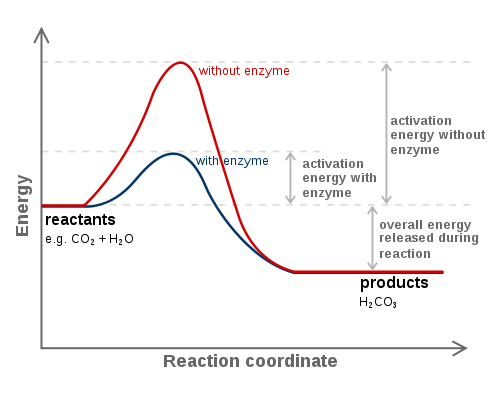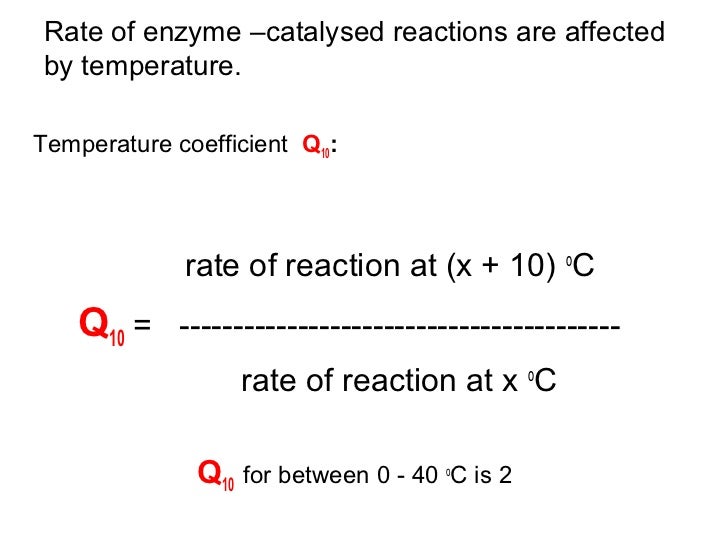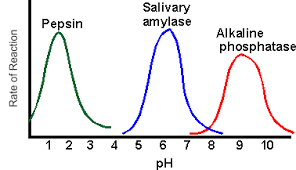Enzymes
0.0 / 5
- Created by: Fredcatley
- Created on: 30-11-18 10:22
Role of enzymes
- Enzymes catalyse specific chemical reactions
- Enzymes are a globular protein with a tertiary structure
- Reactions that enzymes catalyse are reversible
- Enzyme activity is affected by several factors:temperature, pH, enzyme concentration+substrate concentration
- Intracellular enzymes: catalyse reactions within cells
- Extracellular enzymes: catalyse reactions outside of cells
1 of 12
Mechanism of enzyme action: active site+specificit
- Active site of an enzyme is complementary to the specific substrate molecule. Other molecules do not fit into the active site: enzyme cannot catalyse them.
- Different levels of specificity: some enzymes are specific to 1 substrate and some are less specific=catalyse a no.of reactions.
- Enzyme combines with substrate=enzyme-substrate complex: two ideas how interact with the substrates: lock and key, induced-fit
2 of 12
Lock and key hypothesis
- Substrate exactly fitting into the active site=lock and key hypothesis
- Interactions between the R groups of the active site and substrate stabilise the enzyme= substrate altered= enzyme-product complex
- Enzyme release this product and is free to accept another substrate molecule
3 of 12
Induced-fit hypothesis
- Active site does not have a complementary shape to the substrates until it has moulded around the substrates so the are closer together.
- Amino acids in the active siteare brought closer to the substrate to hold it in place+put the substrate under strain. This causes the reaction to proceed to form the product.
4 of 12
Activation energy
- Activation energy: energy needed to overcome a barrier to allow reaction to occur.
- The energy barrier may be overcome by increasing the temperature, pressure or adding a catalyst.
- Enzymes provides an alternative pathwath with a lower activation energy.

5 of 12
Determining initial rates of reactions

6 of 12
Factors effecting enzyme activity: temperature
7 of 12
Factors effecting enzyme activity: temperature coe
- Temp coefficient: ratio between activities of a process, such as an enzyme-catalysed reaction, at two temperatures.

8 of 12
Factors effecting enzyme activity: pH
- pH: measure of the concentration of H+ ions in solution.
- Enzymes function at an optimum pH, above and below this pH the enzyme does not perform as well.
- The optimum pH is specific for each enzyme, the pH range for some enzymes is larger than others.
- Shape of the active site is dertimined by interactions: H + ionic bonding between R groups of the amino acids in the active site.
- As H+ ion concentration changes, some of the bonds break= active site is less effective=complementary shape is lost= substrate cant bind to active site
- The charges on R groups are important in formation of enzyme-substrate complex. Therefore, any changes to the charge will affect the ability of the active site to successfully bind to the substrate molecules.
9 of 12
Factors effecting enzyme activity: pH
The graph shows:
- Each enzyme is active over a range of pH
- As pH increases the activity of each enzyme increases until a maximum is reached.
- Maximum activity occurs at the optimum pH for each enzyme.
- At values of pH above optimum temperature, activity decreases.
- At certain ph there is no activity.

10 of 12
Factors effecting enzyme activity: substrate conce
- Substrate concentration determines the probability of collisions occuring between substrate and enzyme molecules.
- Lower substrate concentration: fewer substrate molecules in solution=fewer will collide+form an enzyme substrate complex, rate of reaction is slower.
11 of 12
Factors effecting enzyme activity: enzyme concentr
- Increased enzyme cocentration: higher availability of active sites=more enzyme-substrate molecules will form.
- Consequently, the rate of reaction will rise until other factors become limiting: substrate concentration, pH and temperature.
12 of 12
Similar Biology resources:
0.0 / 5
1.0 / 5 based on 1 rating
0.0 / 5
1.0 / 5 based on 1 rating
0.0 / 5
4.5 / 5 based on 2 ratings
3.0 / 5 based on 1 rating
2.0 / 5 based on 1 rating
2.5 / 5 based on 3 ratings
0.0 / 5


Comments
No comments have yet been made